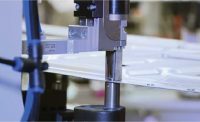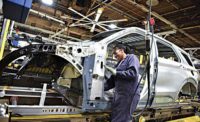If it rolls, floats or flies, lightweighting is one of the biggest challenges facing manufacturers today. The push for new materials is forcing engineers in a variety of industries to explore cost-effective alternatives and develop new assembly processes.
Lightweighting is the No. 1 issue in the automotive industry. Engineers are increasingly adopting lightweight materials for body, chassis, interior, power train and under-the-hood applications.
OEMs and suppliers are scrambling to develop multi-material vehicles that incorporate aluminum, carbon-fiber composites, high-strength steel, magnesium, titanium, and various types of foam, plastic and rubber. They’re also exploring natural fibers such as bamboo and kenaf.
The rush to shave weight may be causing sleepness nights for many engineers. But, it’s also enabling them to rethink traditional assembly processes and develop new joining techniques.
The long-term goal is to reduce overall vehicle weight to improve fuel economy and meet the evolving demands of increasingly electrified vehicle platforms. Typically, a 10 percent reduction in vehicle weight can lead to an 8 percent improvement in fuel economy. However, the big challenge is to cost-effectively join dissimilar materials while meeting increasingly stringent safety and performance standards.
According to ASSEMBLY magazine’s 2018 State of the Profession survey, interest in lightweight materials has surged 11 percentage points in the past year. Almost one-half (48 percent) of respondents claim they are using materials other than traditional steel.
Aluminum is popular with more than three-fourths (82 percent) of those assemblers. Other lightweight materials in demand include plastics (53 percent), carbon-fiber composites (29 percent), high-strength steel (29 percent) and magnesium (11 percent).
A recent survey of automotive executives sponsored by DuPont Automotive confirms those findings. Lightweighting tops the list of strategies that automakers are using to meet the demands of improved vehicle fuel economy mandates.
“The use of lightweight structural materials continues to lead the list of technologies respondents are most focused on to meet the 2025 CAFE (Corporate Average Fuel Economy) standards,” says Brian Fish, North American automotive marketing manager at DuPont Performance Materials.
Currently under review, the controversial 2025 CAFE standards require automakers to deliver a fleet average of at least 54.5 mpg by 2025. An upcoming review by the Environmental Protection Agency and National Highway Traffic Safety Administration will determine the industry’s technological readiness and ability to implement the standards at an acceptable cost.
Although many observers predict the standards will become less stringent under the Trump Administration, automakers and suppliers are pushing ahead with lightweighting efforts. They’re driven by emerging vehicle electrification trends that demand lightweight materials to offset heavy batteries and other new high-voltage components.
“The power train remains the most-cited focus area for vehicle lightweighting efforts, with the chassis running a distant second,” says Fish. “However, vehicle interiors [are growing] as a lightweighting target.
“OEMs are introducing creative lightweighting solutions to help differentiate vehicle interiors,” explains Fish. “[The goal is to improve] passenger safety and comfort, and improve utilization of space through the use of new materials in these critical areas.”
Success Stories
The auto industry has made huge strides in lightweighting in recent years. It’s been a major focus of R&D efforts at automakers such as General Motors.
“Eliminating mass in parts where material is not required for performance, combined with parts consolidation, yields benefits…including the potential for more interior space and vehicle content, increased range and enhanced vehicle performance,” says Ken Kelzer, vice president of global vehicle components and subsystems at General Motors. “It also paves the way for new features…and provides [engineers] a canvas on which to explore designs and shapes not seen today.
“Since 2016, GM has launched 14 new vehicle models with a total mass reduction of more than 5,000 pounds, or more than 350 pounds per vehicle,” claims Kelzer. “Most of the weight reduction is a result of material and technology advancements.”
Traditionally, lightweighting efforts in the auto industry have focused on low-volume sports cars or high-end luxury sedans. But, recent efforts have trickled down to mass-produced vehicles, such as pickup trucks.
Ford Motor Co. set the bar high for the industry when it unveiled its all-aluminum F-150 in 2014. Since then, Ford’s two biggest rivals have launched pickup trucks that also feature weight-saving materials.
Earlier this year, GM unwrapped the 2019 Chevy Silverado 1500. Through extensive use of mixed materials, the new truck weighs less than the outgoing model—up to 450 pounds less for some versions.
“The weight savings comes from extensive use of mixed materials and advanced manufacturing processes throughout the next-gen truck,” says Tim Herrick, executive chief engineer of full-size trucks at GM. “This allowed [us] to use the right material for the application and optimize every component for mass, durability, safety and functionality to meet our customers’ needs.”
The body is 88 pounds lighter than before. All exterior swing panels, such as doors, hood and tailgate, are aluminum, while fixed panels, such as fenders, roof and bed, are steel. The underlying safety cage uses seven different grades of steel, each tailored for the specific application.
“The fully boxed steel frame is also 88 pounds lighter than its predecessor, while offering 10 percent greater torsional rigidity,” claims Herrick. “Eighty percent of the frame is made of high-strength steel varying from 2 to 5 millimeters in thickness. Every millimeter is optimized for performance using a variety of processes, including hydroforming, roll forming, conventional stamping and tailor-rolled blanking.”
In addition, GM engineers used lightweight materials to design the 2019 GMC Sierra pickup. It features a carbon-fiber composite box that is 62 pounds lighter than its steel predecessor. And, the vehicle uses aluminum for the doors, hood and tailgate, while relying on high-strengh steel for its fenders and roof to shave another 360 pounds.
Engineers at FCA have also been busy lightweighting one of the company’s most popular vehicles. The overall weight of the 2019 Dodge Ram 1500 pickup truck has been reduced by 225 pounds. The engineers achieved most of that reduction in the truck’s frame, which is made from a combination of aluminum and high-strength steel.
While all those weight reduction efforts are impressive, most experts say there’s still much more to done.
“A lot of the low-hanging fruit has already been tapped,” says Alan Taub, chief technology officer at Lightweight Innovations for Tomorrow (LIFT), a public-private partnership committed to the development and deployment of advanced lightweight metal manufacturing technologies. “Now, every option is in play.
“I don’t know of any OEM that isn’t targeting at least one weight class reduction on new models that they’re developing,” notes Taub, who previously worked in R&D at Ford, GM and General Electric. “Over the next two decades, we expect to see incremental improvements in weight reduction on every new vehicle and every new component. This is a never-ending battle and every component is being challenged.
“One area that’s getting increased priority is electric vehicles,” adds Taub. “In addition to battery cells, engineers are focusing on reducing the weight of battery modules, heat transfer systems and electric motors.”
Steel Substitutes
The biggest change in recent years has been the widespread use of advanced high-strength steel, which has been substituted for traditional low-carbon steel.
“Because high-strength steel is stronger, you can make the gauge thinner and achieve weight savings anywhere from 20 percent to 25 percent,” explains Taub. “Manufacturers can now do that at an average cost below $1 per pound.
“Aluminum offers even greater weight savings, ranging from 40 percent to 50 percent,” Taub points out. “But, that weight savings comes at a higher cost. Savings typically range from $1.75 to $2.25 per pound.”
That’s how Ford reduced the weight of its F-150 pickup truck by more than 700 pounds. Engineers used advanced high-strength steel in the frame and aluminum in the body.
“Despite the ongoing improvements and advancements in lightweighting the auto industry has experienced in the past few years, there is still much more that can be done,” claims Doug Richman, vice president of engineering and technology at Kaiser Aluminum Corp. “The car companies have done a good job of applying weight reduction to meet affordability and CO2 objectives.
“Weight reduction varies by size and has more benefit to larger vehicles,” says Richman. “This is also where there’s still more that can be done in terms of reducing mass. However, additional lightweighting efforts are dependent upon the needs of automakers and their customers.”
According to Richman, there are a variety of lightweight applications being explored, including hoods, fenders, crash management systems and the vehicle body structure itself. Currently, aluminum hoods make up 50 percent of the vehicle fleet produced in North America, but they are projected to grow to 80 percent by 2025.
Bumper and crash management systems, which support impact, safety and performance of a vehicle, are also growing. Industry trends forecast significant growth in body structures and aluminum doors in the next 25 years.
"To further improve fuel economy, battery range, safety and overall driving performance, automakers no longer default to a single material," says Abey Abraham, managing director of automotive materials at Ducker Worldwide LLC, a market research and consulting firm. "Instead, [they] are pursuing a multi-material design approach where the best material is chosen for the best application. This design evaluation is...driving aluminum's increased market penetration in the auto sector."
“Lightweighting is an ongoing process, but it has progressed a great deal,” adds Tim Foecke, Ph.D., director of the Center for Automotive Lightweighting at the National Institute of Standards and Technology. “In the past decade, there has been a competition between advanced high-strength steel and aluminum to displace mild steels in lightweight auto bodies. Each material has its issues.
“Aluminum is somewhat more expensive and more difficult to form in terms of accurate die designs that compensate for things like elastic spring back of parts,” explains Foecke. “Joining aluminum body panels to steel car components is tricky. Welding doesn’t work well, and the two metals touching sets up a possible galvanic corrosion issue. However, you can superplastic form it at elevated temperatures to make complicated components with fewer joints.
“Advanced high-strength steels are somewhat more expensive, fail unexpectely during manufacturing near the limit strains vs. the fairly forgiving behavior of mild steels, and tend to have metastable microstructures that can be disrupted by welding,” claims Foecke. “But, they are extremely strong and manufacturers take advantage of their high work hardening rate to make parts with optimal properties.”
Alternative Materials
While aluminum remains the fastest-growing lightweight material, magnesium and carbon-fiber composites are becoming more popular with automotive engineers.
Magnesium is 75 percent lighter than steel and 33 percent lighter than aluminum. However, magnesium components currently account for only 1 percent, or 33 pounds, of a typical car’s weight. Most applications have been confined to expensive sports cars.
Magnesium is not widely used to make auto parts because it is intrinsically a brittle metal not known for malleable properties. Usually, the material is formed at elevated temperatures between 200 and 400 C.
“Magnesium is the lightest weight structural metal and among the newest materials used in vehicle manufacturing,” says Darrell Herling, director of LightMAT, a lightweight materials research consortium sponsored by the U.S. Department of Energy.
“Magnesium parts can be bolted or welded to [other components] in applications such as interior door beams,” adds Herling. “But, if the joined area is exposed to moisture, magnesium will interact with most other metals and cause corrosion.”
Carbon-fiber composites are also slowly finding their way into more and more vehicles. “Potential applications include closure panels and noncritical structures such as seats and instrument panels,” says Uday Vaidya, chief technology officer at the Institute for Advanced Composites Manufacturing Innovation. “Under-the-hood components are more challenging, but possible applications include engine cradles, pans and covers.
“One area that we’re studying is finding new ways to join composites and metals,” explains Vaidya. “There are still a lot of gaps that need to be filled. We’re looking at things such as joint design and parts curing.”
“Polymer composites for automotive lightweighting lag behind [aluminum and high-strength steel], primarily due to multiple cost issues,” adds NIST’s Foecke. “The cycle time for composite parts is quite long compared to metals, so more equipment is required to produce the same number of parts per hour.
“Fastening polymers to metals is also very tricky, as the thermal expansion coefficient of polymers is 20 to 25 times that of metals and the joints get highly stressed with temperature changes,” Foecke points out.
“Finally, to put them into structural components that would be expected to contribute to energy absorption during a crash, you need to [carefully] understand how they fail,” notes Foecke. “Polymer composites are essentially brittle, and crumble in a crash. It’s very difficult to predict their behavior.”
Joining Breakthroughs
Automotive engineers are working on a variety of new technologies that make it easier to join dissimilar materials. Those efforts are critical to future lightweighting initiatives.
“It is clear the majority of vehicles going forward will be multi-material in their design,” says Kaiser Aluminum’s Richman. “Independent of material, joining processes are critical in all automotive applications, as those processes influence vehicle durability; noise, vibration and harshness performance; handling; and collision energy management.
“Many automobile bodies and structures are an optimized combination of two or more materials,” explains Richman. “The most common is a steel body with aluminum closures. With the increased emphasis on vehicle energy efficiency and CO2 emissions, OEMs are using a multi-material approach to most new vehicle designs and expanding the multi-material methodology to body-in-white applications.”
“A key issue in welding steel to aluminum is the formation of undesirable intermetallic phases which can reduce the mechanical strength of the joint,” adds LIFT’s Taub. “There are also challenges related to handling and processing of components, such as cleaning parts during welds, e-coating or painting. Other joining methods have challenges as well, including surface preparation in the use of adhesives and cost in the use of rivets.”
Many assembly equipment vendors have recently unveiled products that address some of those lightweight material joining challenges. For instance, engineers at Weber Screwdriving Systems Inc. developed TSS technology.
Designed for plastic and composite material joining, TSS can be used on similar or dissimilar materials in a variety of applications where traditional adhesives or screws don’t provide the strength and rigidity required.
During the TSS joining process, plastic components are melted, creating a thermal adhesive bond. It allows engineers to place plastic bosses in sandwich structures, which consist of a honeycomb or foam core with outer layers of fiber-reinforced plastics.
“We have seen a definite upward demand for fastening lightweight materials,” says Tom Rougeux, regional sales director at Weber Screwdriving Systems. “TSS was developed specifically to meet that demand.
“The technology essentially controls the fastening parameters through rotational speed, Z-axis speed, and what’s known as torque and depth gradient,” explains Rougeux. “The rate of change of these variables is tightly controlled through a closed-loop process with our C-50 process controller.”
Another innovative assembly process was recently developed by engineers at the American Chemistry Council and Michigan State University. They have created a “reversible” bonding process.
The reusable, multi-material bonding substance can increase the strength of vehicle part adhesion by 40 percent. It can be applied and set in under a minute, then melted and removed in another minute.
“Ferromagnetic nanoparticulate electromagnetic glue involves nanosized spheres of iron inside a polymer,” says Mahmoodul Haq, an engineering professor at Michigan State University’s Composite Vehicle Research Center. “When alternating electric current changes the magnetic field rapidly, the nanoparticle balls vibrate. Vibration causes friction, causing the polymer temperature to rise 400 to 800 F within seconds.
“The exacting melting temperature depends on the type of adhesive being used,” adds Haq. “But, the process works with most adhesives and materials.”
“The bonding agent has been shown to work when joining dissimilar materials, such as aluminum to steel and steel to composite,” says Mike Day, a technical consultant at the American Chemistry Council. “[The reversible bonding process produces no] apparent damage to any composite fibers. Amazingly, it even increases the overall joint strength.
“The magic behind the process is that it ultimately will eliminate need for many physical fasteners like nuts, bolts, clips, clamps and snaps in the assembly and repair process, saving time and weight and increasing vehicle fuel economy,” adds Day.
“This bonding technology [could] revolutionize the [auto industry] by giving us the ability to bond, unbond and strengthen structural parts in a way that helps keep weight down, and changes the way we think about joint fatigue altogether,” claims Day.
“The target of a lot of our work so far has been body and chassis structural applications where it has been challenging to use lightweight materials,” says Day. “More development work is necessary, but short-term applications for the technology could include fascias and front-end modules. There also may be some interior uses, especially in applications where disassembly and repair is necessary.”










